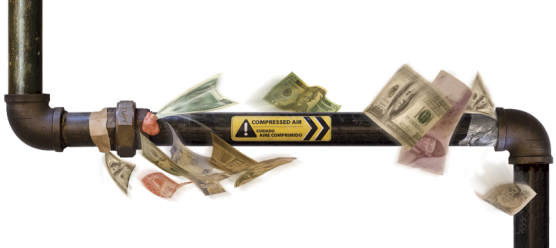Almost every industry uses compressed air in some capacity. It
is often referred to as the “fourth utility” In an industrial setting, next
to water, gas and electric. and in many cases, is the largest energy user in
the plant. With an average cost of $ 0.25 per every 1000 Standard Cubic Feet
used, compressed air can be expensive to produce so it is very important to
use this utility as efficiently as possible. When evaluating the
performance of a compressed air system, it's important to look at the system
as a whole.
When you operate point-of-use devices at a higher pressure
than necessary to perform a certain job or function, you are creating
"artificial demand". This results in excess air volume being
consumed, increasing the amount of energy being lost to waste. For
example, plant personnel or operators increase the supply pressure in an
effort to improve the end use devices performance. When there is a leak in
the system, the line pressure will actually begin to drop
and performance begins to deteriorate in other areas in the
plant. This not only puts stress on the existing compressor
but it also leads to the false idea that a larger or secondary compressor is
needed.
Here's a quick reference on how operating pressure can
directly affect operating cost:
 Our Model # 1101 Super Air Nozzle requires 14 SCFM @ 80 PSIG. Based on the average operating cost of $ 0.25 per 1000 SCF used, it would cost $ 0.21 per hour to operate this nozzle. (14 SCFM x $ 0.25 x 60 minutes / 1000 SCF = $ 0.21)
If you were able to use the same Model # 1101 Super
Air Nozzle operating at only 40 PSIG, while still achieving
the desired end result, the air demand would decrease to only 8.1 SCFM,
reducing the hourly cost to $ 0.12. (8.1 SCFM x $ 0.25 x 60 minute /
1000 SCF = $ 0.12)

Leaks in a compressed air system can account for up to 30% of
the total operational cost of the compressor, wasting thousands of dollars of
electricity per year. Some of the more common places for a leak to occur
would be at connection points such as valves, unions, couplings,
fittings, etc.
In this table, you will see that a certain amount of air
volume is lost through an orifice or opening. If you have several leaks
throughout your facility, it isn’t gong to take long for the waste and high
operating costs to quickly add up as well as potential increases in repair or
maintenance costs for the existing compressor. The industry average shows
that any leakage more than 10%, shows there are areas where
operational improvements could be made in a compressed air system.
Stay tuned to our blog over the
next few weeks as we will discuss how following a few simple
steps can help optimize your current compressed air
system, in many cases, reducing energy costs related to compressed air waste,
leading to a more economical operation.
In the meantime, if you have any questions or would like to
discuss a particular application,
give me a call at +351 932308640.
José Garcia Araújo
Application Engineer j.araujo@tecmer.pt www.tecmer.pt |

Comentários
Enviar um comentário